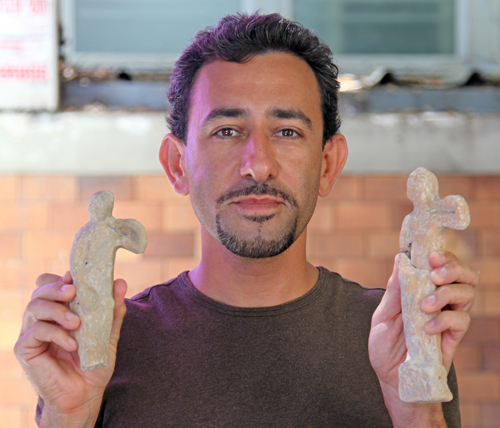 Three Roman-era figurines of Aphrodite, the goddess of love, have been unearthed at an archaeological site east of the sea of Galilee in Israel. Sussita, known as Hippos to the Greeks on account of the horse’s head-shaped hill on which it was built, was a Greco-Roman town that became one of the 10 cities (the Decapolis) in Coele-Syria that were granted some independence when Pompey conquered in 63 BC. (Other Decapolis cities include Qanawat and Jerash.)
Three Roman-era figurines of Aphrodite, the goddess of love, have been unearthed at an archaeological site east of the sea of Galilee in Israel. Sussita, known as Hippos to the Greeks on account of the horse’s head-shaped hill on which it was built, was a Greco-Roman town that became one of the 10 cities (the Decapolis) in Coele-Syria that were granted some independence when Pompey conquered in 63 BC. (Other Decapolis cities include Qanawat and Jerash.)
It is thought that the figurines, measuring 23cm high, date from the fourth century AD a time when Constantine the Great laid out the beginnings of the Byzantine empire and Hippo would have become increasingly Christian. This discovery suggests that pagan beliefs persisted, although the fact that the miniature Aphrodites were buried whole, as if hidden, could suggest that their worship could have been clandestine or suppressed. The figurines are depicted in the ‘Venus pudica‘ pose, showing the goddess modestly covering herself with her hands.
The excavation of the site of Hippo, now in its 10th season, is being done by researchers of the Zinman Institute of Archaeology at the University of Haifa, headed by Professor Arthur Segal and Dr Michael Eisenberg. Segal suggests: It is possible that during the fourth century AD, when Christianity was gradually becoming the governing religion in the Roman empire, there were still a number of inhabitants in Sussita who remained loyal to the goddess of love and therefore wished to hide and preserve these items.
It is thought that the figurines have been buried for over 1,500 years. They came to light when archaeologists working in the forum area of the site uncovered a shop.
Several other structures and items of interest have also been uncovered during the excavation at Hippo. These include:
 An odeion a small, roofed theatre for poetry-reading and musical recitals, which is the first of its kind to be exposed in Israel. An odeion was generally used for intimate performances for a select audience this one can seat about 600. According to the researchers, the construction is of high quality and it seems that it can be dated back to the first century BC or AD.
An odeion a small, roofed theatre for poetry-reading and musical recitals, which is the first of its kind to be exposed in Israel. An odeion was generally used for intimate performances for a select audience this one can seat about 600. According to the researchers, the construction is of high quality and it seems that it can be dated back to the first century BC or AD.- A basilica with a roof that would have been used for public gatherings in bad weather. According to the University of Haifa, this is the second basilica to be exposed in Israel, the first being the Roman basilica of Samaria. Professor Segal is quoted as saying: Just the look of the restored columns is enough to get an impression of the beauty and tremendousness of Roman architecture during that period.
- Some fourth-century AD houses, which provide rare insight into the daily lives of the inhabitants of Sussita. All of the houses that were exposed surround a stone-paved courtyard. The researchers assume that this style of planning is evidence of everyday household activity taking place in the courtyard, including the cooking.
The Polish Academy of Sciences in Warsaw and the Concordia University of Minnesota, USA, are collaborating on this project with the University of Haifa. The Israel Nature and Natural Parks Protection Authority also support the work.
Photos by the Division of Communications and Media Relations, University of Haifa.
